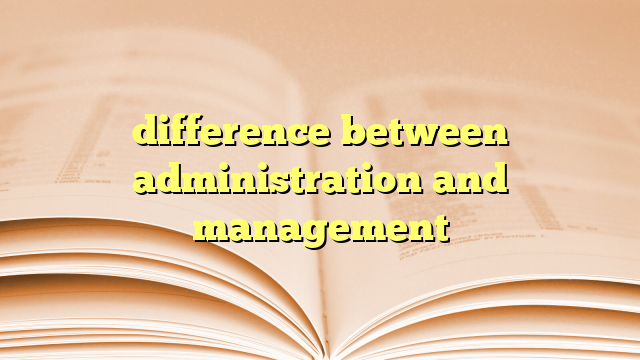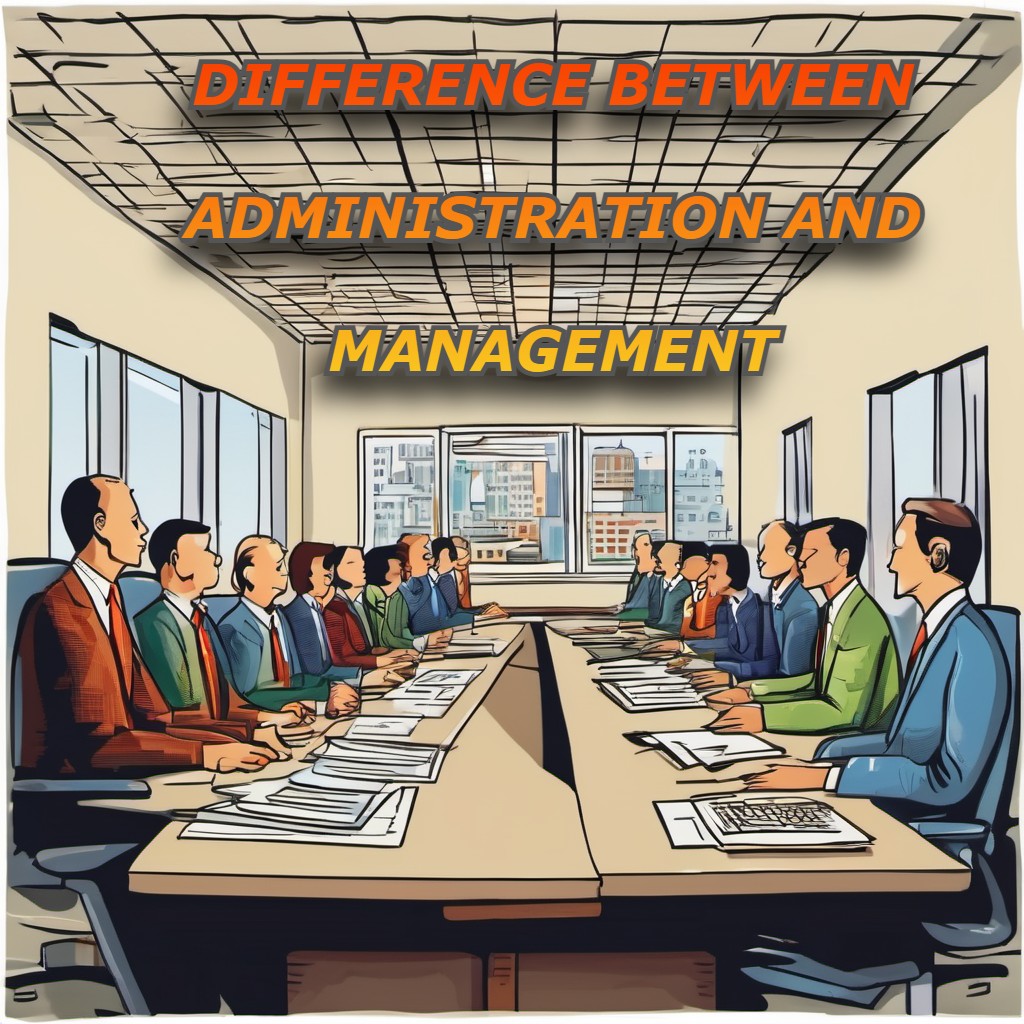Welcome to our blog post discussing the difference between administration and management. Today, we will explore these two crucial aspects of organizational structure and provide a clear understanding of their distinctions. Whether you are a business professional, student, or simply curious about the intricacies of management and administration, this article will shed light on the unique roles and responsibilities associated with each term. So, let’s dive into the key differentiators between administration and management.
What is Administration?
Administration can be defined as the process of organizing and managing the operations of an organization. It involves coordinating and supervising various activities to ensure the smooth functioning of the entity. On the other hand, management refers to the act of directing and controlling resources to achieve organizational goals. It encompasses tasks such as planning, organizing, leading, and controlling. Both administration and management play crucial roles in the effective functioning of any organization, ensuring that resources are utilized efficiently and goals are achieved.

What is Management?
Management refers to the process of coordinating and supervising resources within an organization to achieve its goals and objectives effectively. It involves tasks such as planning, organizing, decision-making, and leading. On the other hand, administration focuses on the implementation of policies and procedures set by management, ensuring smooth day-to-day operations, and handling routine tasks. While management deals with broader strategic aspects, administration deals with the practical aspects of running an organization.
Management and administration are two distinct but interconnected concepts.
Management and administration are two distinct but interconnected concepts. Management involves tasks like planning, organizing, leading, and controlling, while administration focuses on implementing policies and procedures and handling routine operations. Both are crucial for efficient resource utilization and goal achievement in organizations. While management deals with broader strategic aspects, administration handles the practical day-to-day tasks of running an organization. Together, they ensure the effective coordination and supervision of resources to achieve an organization’s goals and objectives.
Difference between Management and Administration
Management involves tasks like planning, organizing, leading, and controlling, while administration focuses on implementing policies and procedures and handling routine operations. Both are crucial for efficient resource utilization and goal achievement in organizations. Together, they ensure the effective coordination and supervision of resources to achieve an organization’s goals and objectives.
| Basis | Management | Administration |
|---|---|---|
| Meaning | Management encompasses the process of strategically planning, organizing resources, coordinating efforts, directing activities, and maintaining control within an organization to achieve its intended goals and objectives. | Administration involves overseeing an organization’s day-to-day operations, ensuring they run smoothly by implementing policies and decisions set by management. |
| Focus | Management is primarily concerned with planning, organizing, directing, and controlling resources to achieve organizational goals. | Administration focuses on establishing policies, guidelines, and procedures to ensure the smooth operation of the organization. |
| Scope | Management is a broader term that encompasses various functions such as planning, organizing, staffing, leading, and controlling. | Administration is a narrower term, often associated with the implementation of policies, rules, and regulations set by the management. |
| Key Person | Manager is the key person in the case of management. | Administrator is the key person in the case of administration. |
| Decision-Making | Managers make strategic decisions related to setting goals, formulating plans, and allocating resources. | Administrators make decisions related to implementing policies, procedures, and guidelines set by the management. |
| Nature | It is more dynamic, action-oriented, and focused on achieving objectives through efficient resource utilization. | It is more concerned with establishing a stable framework, ensuring adherence to rules, and maintaining order within the organisation. |
| Time Horizon | Managers focus on both short-term and long-term goals, with an emphasis on adapting to changing circumstances. | Administrators tend to have a longer-term perspective, aiming to establish enduring structures and processes. |
| Function | Management involves guiding, directing, and leading employees toward achieving organizational goals. | Administration involves establishing policies, rules, and regulations that guide the actions of employees and ensure organisational efficiency. |
| Role | The role of management is executive in nature. | The role of administration is decisive in nature. |

The Roles and Responsibilities
Both management and administration play vital roles in organizations by ensuring efficient resource utilization and goal achievement. While management focuses on strategic aspects, administration handles day-to-day operational tasks. By working together, they ensure effective coordination and supervision of resources to meet organizational goals. Management encompasses activities such as planning, organizing, leading, and controlling, while administration is responsible for implementing policies and procedures and managing routine operations. These two functions are essential for optimizing resource utilization and achieving desired outcomes in organizations.
Management and administration have distinct roles and responsibilities in organizations. Management focuses on strategic aspects, such as planning, organizing, leading, and controlling, while administration handles day-to-day operational tasks and implements policies and procedures. Both functions work together to ensure efficient resource utilization and goal achievement. Their collaboration enables effective coordination and supervision of resources to meet organizational objectives. By optimizing resource utilization and achieving desired outcomes, management and administration contribute to the overall success of an organization.
Key Responsibilities of Administration

The key responsibilities of an administrator typically include:
- Coordinating Office Activities:
This involves ensuring efficiency and compliance to company policies, supervising administrative staff, and dividing responsibilities to ensure performance[1]. - Managing Administrative Tasks:
Such as managing agendas, travel arrangements, appointments, phone calls, and correspondence for the upper management, as well as supporting budgeting and bookkeeping procedures[1]. - Maintaining Documentation and Filing:
Keeping filing and documentation up to date to ensure the smooth running of the business[2]. - Organizational Tasks:
This includes maintaining calendars, setting appointments, filing various documents, maintaining databases, and creating filing systems[5]. - Communication and Customer Interaction:
Some administrators may be required to be customer-facing via email, phone, or greeting visitors[2].
These responsibilities may vary based on the specific industry and the size of the business, but they generally revolve around ensuring the efficient operation of the office and providing support to the management and staff.
Key Responsibilities of Management
Key Responsibilities of Management:
- Planning: Developing strategies, setting goals, and creating plans to achieve desired outcomes.
- Organizing: Structuring the organization, allocating resources, and assigning tasks to achieve objectives.
- Staffing: Recruiting, selecting, and training employees to fill positions within the company.
- Leading: Guiding, motivating, and inspiring employees to work effectively towards achieving goals.
- Controlling: Evaluating performance, improving processes, and implementing standards to measure and compare results.
- Communication: Sharing information, providing feedback, and fostering open dialogue among team members.
- Decision-making: Making informed decisions based on data, analysis, and input from stakeholders.
- Problem-solving: Identifying and addressing issues, finding solutions, and implementing corrective actions.
- Innovation: Encouraging creativity, fostering innovation, and adapting to changes in the business environment.
- Continuous improvement: Pursuing ongoing improvement, learning from mistakes, and implementing best practices.
- Customer focus: Understanding customer needs, preferences, and expectations, and aligning strategies to meet them.
- Quality management: Ensuring high-quality products and services, implementing quality control measures, and continuously improving quality.
- Performance measurement: Establishing metrics, tracking progress, and using data to make informed decisions.
- Collaboration: Building strong relationships, fostering teamwork, and working collaboratively with stakeholders.
These responsibilities are essential for effective management and can be applied in various industries and organizations. By focusing on these key areas, managers can improve their performance, enhance their team’s productivity, and drive the success of their organization.
Conclusion
Both management and administration are crucial for achieving the final goal. These two go hand in hand since administration and management are incomplete without the other. If the system has poor administration, weak policies and procedures will be created. This will lead to poor decisions that will adversely impact everyone from higher level to lower level. In the end, managers will have no clue of what path to take for achieving the end goal.
On the other hand, if the administration is strong but management is weak, it will also cripple the system. Even if the policies are effective, due to weak management, their implementation will be poor. This will hamper the workflow, efficiency, and productivity of group of people in the company.

